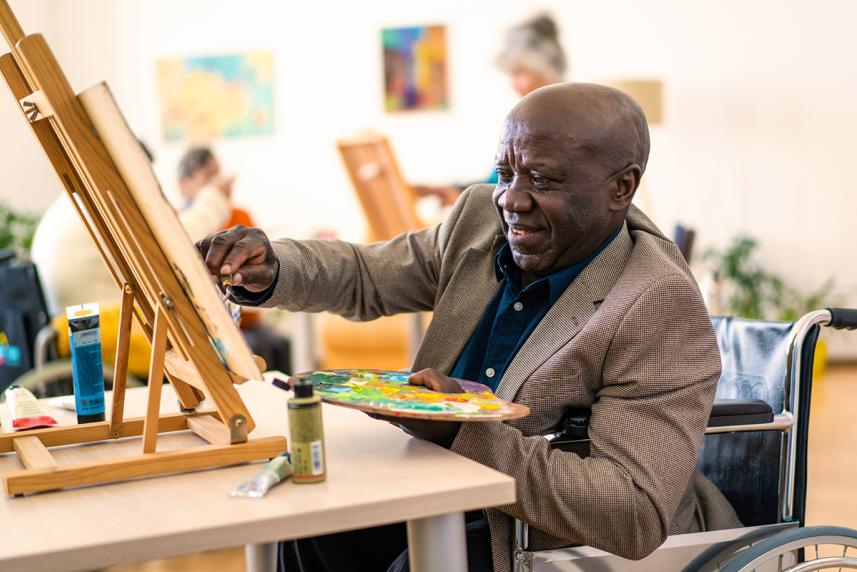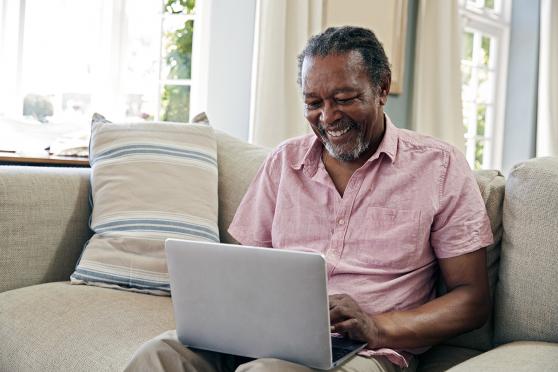For a healthier, happier life, unleash your inner artist
Tap into your creative side for big health rewards.

Aches and pains? Join the club. Stressed out? Who isn’t? Got a headache from the never-ending cycle of doom on the news? Well, of course you do. But before you reach for an aspirin or call the doctor, try this instead: Grab your knitting needles or your paintbrushes — or scoop up a hunk of clay.
Turns out, the simple act of making art is good for your physical — and mental — health. In a landmark study from George Washington University, researchers found that older adults who were engaged in the arts — any kind of art — used fewer medications, went to the doctor less often, experienced fewer falls, and reported lower levels of depression and loneliness. Plus, they had a way more positive outlook than their less-artsy peers.
Art can help you live longer, too — in a study of 6,000 adults aged 50 and older, those who were involved in art activities had a 31 percent lower risk of dying during the 14-year study. There’s even a link between creativity and a stronger immune system.
But wait — it gets even better. Research from the National Endowment for the Arts found that older adults who both created art and attended arts events had significantly lower levels of hypertension, higher cognitive ability, and fewer physical limitations than people who weren’t involved in arts at all.
So people like Carolyn McNally, of Hershey, Pennsylvania are on to something. An avid needleworker, she picks up her current project whenever she feels a headache or pain from her sciatica coming on. “It’s so calming,” she explains. “When I concentrate on the stitches, I can feel myself relax — my headache goes away and my shoulder pain starts to ease. I lose all sense of time. For me, creativity is so satisfying.”
Join IBX for one of our Weekday Wellness events! These free, virtual events are open to the public. Register now to secure your spot.
As McNally can attest — and as science is proving — needlework may be old-school, but it’s a super-healthy form of art. In one study of eating disorder patients who were taught to knit, 74 percent reported that the intensity of their eating anxieties had diminished. And research in the British Journal of Occupational Therapy, based on a survey of more than 3,500 adults, found that knitters reported significantly higher cognitive functioning and greater happiness.
“Knitting is one of many practices that evoke the relaxation response by breaking the train of everyday thought, which leads to a relaxed state both physically and mentally,” explains Dr. Herbert Benson, MD, professor emeritus of mind-body medicine at Harvard Medical School. “Humans over the millennia have found many ways to evoke this response — deep breathing, meditation, repetitive prayer, yoga, knitting, what have you – the most important part is to find an activity that helps you quiet your mind and elicit the relaxation response.”
In other words, art is good for your body — and your mind. Or, as Melissa Batchelor, director of the George Washington University Center for Aging, Health, and Humanities, puts it, “Creativity is like chocolate for the brain.”
There are all kinds of good reasons to tap into your creativity, but the best one is: It’s fun. Not sure how to get started? Try these simple strategies.
Embrace your inner artist
Making art is an opportunity for self-discovery, says Raquel Stephenson, professor of art therapy at Lesley University in Cambridge, Massachusetts and author of Art Therapy and Creative Aging: Reclaiming Elderhood for Health and Well-Being. “Even people who have been told since childhood that they’re not good at art often learn that they’re artists deep down. Creativity, after all, is basically problem-solving, seeing things through a new lens in a new way, something older people are primed for. They have more experience to draw from and they’re less worried about what other people think. Now is the perfect time to tap into your own creativity.”
So instead of thinking, I can’t draw a straight line, think about the art you’d love to make. Then make it.
Learn a new skill
If there’s an art or craft you’ve been itching to try, classes are a good way to begin. In the quarantine, you can find opportunities for online lessons. “People are doing amazing things over platforms like Zoom,” says Stephenson. “It gives everybody the opportunity to see one another’s artwork, and there are all sorts of ways to help you get your creative juices flowing. Sure, you don’t have the energy that happens when people are making art together in the same space, but there are lots of pluses, like the shorter time span of online classes and the chance for other family members to take part.” Some ways to jump in:
- Be fearless. Every season, Independence Blue Cross (IBX) offers new online arts and crafts classes — and even provides the materials you’ll need to complete a project. On the docket now: Sculpting and growing your own succulent garden. Check out the latest offerings here.
- Be crafty. Your local craft or art-supply store may offer virtual how-to sessions. The national chain Michaels’s, for example, offers a wide variety of free online art classes, from crochet for beginners to basic jewelry-making, as well as in-store classes that vary by location.
- Be curious. Have you always wondered how to go about sketching a portrait or making a quilt? You can learn how to do just about any art form by watching online how-to videos. The best place to get started: Go to youtube.com and search for the art or craft you’re curious about. More than likely, dozens of videos will pop up, with a master artist taking you step-by-step through the basics. The best part? You can play them over and over until you get the techniques down pat.
Brush up on old skills with new friends
Not only will you improve your skills, you’ll also enjoy one of the greatest benefits: the joy of making art with other people. Social interaction, after all, is an important path to a stronger mind, a better memory, and reduced stress. A University of Texas study found that the more social interactions you have, the more active — and the more physically healthy — you’re likely to be. And hanging out with friends can even improve your cardiovascular health.
So, consider starting up an art group with old and new friends — you can improve your skills together, inspire one another, and just have fun. The sky’s the limit: You can form anything from a knitting group to a quilting circle to a plein-air art club that goes out into the countryside to paint landscapes. Some get-started strategies:
- Go social. A simple Facebook post can get the ball rolling. Let your social network know about your plans for an art group; chances are other like-minded people will be eager to join in.
- Find your people. Sites like Meetup.com and Eventbrite.com have loads of small, informal gatherings; there may already be a group in your area devoted to the art form you love. And if there’s not, you can use the site to organize — and publicize — your own group.
- Go old-school. Inquire about classes at your public library or community center, or through the adult education division of your school district or community college.



